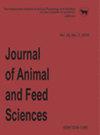饲喂三种常见温带草青贮饲料的肉牛粪便中脂质特征的比较及其与饲料组成的相关性
IF 1.5
4区 农林科学
Q3 AGRICULTURE, DAIRY & ANIMAL SCIENCE
引用次数: 0
摘要
粪便脂质沉积特征可能因饮食而异。通过分析17种不同的脂质化合物并计算它们之间的比例,我们分析了不同日粮喂养的肉牛的粪便脂质(脂肪醇、甾烷醇和古酚)的组成。在这项研究中,我们测量了本文章由计算机程序翻译,如有差异,请以英文原文为准。
Comparison of lipid profiles in the faeces of beef cattle
fed three common temperate grass silage diets
and their relevance to dietary composition
. Faecal lipidome signatures may vary depending on diet. Analyzing 17 different lipidome compounds and calculating ratios between them, we analysed the composition of faecal lipidomes (fatty alcohols, stanols, and archaeol) of beef cattle fed different diets. In this study, we measured the faecal lipidome profiles of
求助全文
通过发布文献求助,成功后即可免费获取论文全文。
去求助
来源期刊

Journal of Animal and Feed Sciences
农林科学-奶制品与动物科学
CiteScore
2.10
自引率
0.00%
发文量
42
审稿时长
3 months
期刊介绍:
Journal of Animal and Feed Sciences (JAFS, J. Anim. Feed Sci.) has been published by the Kielanowski Institute of Animal Physiology and Nutrition, Polish Academy of Sciences in Jabłonna (Poland) since 1991. It is a continuation of the Polish-language journal Roczniki Nauk Rolniczych. Seria B, Zootechniczna published by the Polish Academy of Sciences since 1969.
JAFS is an international scientific journal published quarterly, about 40 papers per year including original papers, short communications and occasionally reviews. All papers are peer-reviewed and related to basic and applied researches in the field of animal breeding and genetics, physiology of nutrition, animal feeding, feed technology and food preservation. The journal distinguishes the multidisciplinary nature of physiological and nutritional sciences and so includes papers specialized in all fields connected with animal well-being, including molecular and cell biology and the emerging area of genetics.
 求助内容:
求助内容: 应助结果提醒方式:
应助结果提醒方式:


